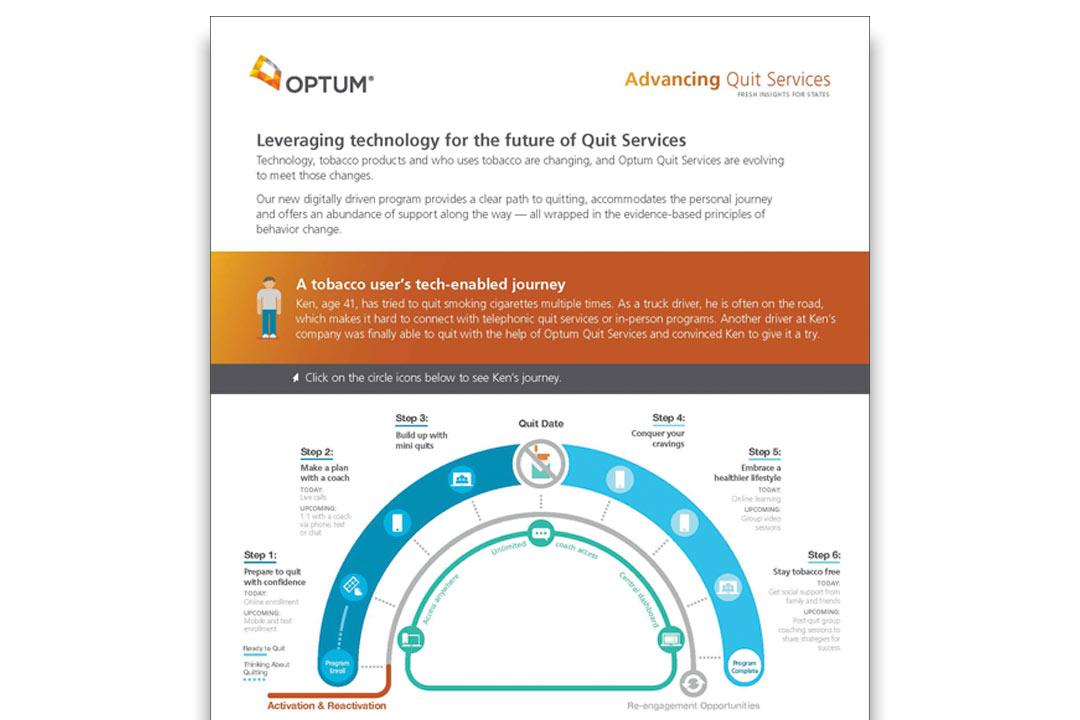Technology helps reduce barriers to tobacco cessation
Optum has provided tobacco cessation programs for more than three decades. During the time, we have seen a lot of change, especially as e-cigarettes and vaping grow in popularity.
Similar to other areas our lives, one of the biggest evolutions has been the emergence of new technologies and how society interacts with them. We now have the opportunity to reach and engage people in a variety of ways far beyond just a phone line.
Meeting people where they are
While early quit services offered connection only by phone, our programs today include digital options to enroll and engage while retaining that human touch. They also offer one-on-one chat with a coach, text connections and a structured yet personalized online experience that includes education, reminders and tracking tools. These tools allow users to see how many hours of their lives they got back and how much money quitting helped them save.
We have also reimagined social support. By incorporating group video interactions, participants can normalize their journey, share strategies for urge management and hold each other accountable.
Creating a personalized journey
This variety of modalities is designed not just to increase enrollment but also to keep people engaged in the program. When they have choices, participants can make the commitment to start and then figure out the next action that’s best for them, as shown in the interactive infographic below:
Infographic
Leveraging technology for the future of Quit Services
Technology, tobacco products and who uses tobacco are changing, and Optum Quit Services are evolving to meet those changes.

The expansion of digital offerings can also help reach different demographics. For example, rural populations — 85% of whom use the internet1 — can get peer support via online group sessions.
And in locations where connecting with others on the quit journey for in-person support likely isn’t possible, that can make a big difference.
Boosting success with choice
Giving people choice — from how they enroll to which journey they’ll take toward quitting and staying nicotine-free — is proving to increase program efficacy. Participants in our commercial employer populations who use digital services have a 57% quit rate,2 as compared to a 51% overall quit rate.3
Participants who engage in a combination of calls, website use and texting are 2.2 times as likely to quit than those engaging in calls alone (at 1.5 times) or via a website, text or both (at 1 times).4
Continuing to evolve quit services
To keep pace with the changing needs of tobacco users, we are expanding our Quit Services to be more digital, flexible and comprehensive. As we modernize with the Rally Coach™ digital engagement platform, we remain committed to keeping evidence-based behavior change techniques at the core of our solution.
Added capabilities include:
- Pre-quit group coaching sessions to build motivation and increase confidence
- Post-quit group coaching sessions to share strategies for success
- More engaging self-paced learning options such as short videos complemented by a mix of quizzes, discussion forums and journaling
We know online interventions are only effective when they are interactive, personalized and include approaches such as behavior change strategies, goals and planning, and social support.
At the core of our evolving program, we’re incorporating ways to personalize content and build in essential behavioral change support beyond tobacco. This will help people with overall health and well-being topics, such as nutrition, sleep and exercise.
In collaboration with 24 state clients and a list of employer and health plan groups, we’re creating a healthier world, one “quitter” at a time.
- Pew Research. Internet/Broadband Fact Sheet. June 12, 2019.
- Optum Quit For Life® engagement data through 2019.
- Quit For Life employer book of business survey results. Results measured among responders to a survey at six months post-program enrollment, with quit-rate success defined as 30+ days of abstinence from all forms of tobacco, cumulative from 2006 to Q2 2018.
- Optum Center for Wellbeing Research (OCWR) and Quit For Life program.


